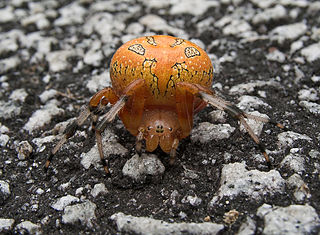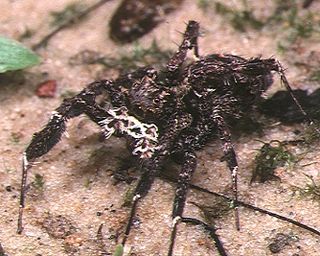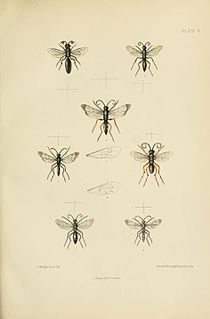
The Acari are a taxon of arachnids that contains mites and ticks. The diversity of the Acari is extraordinary and their fossil history goes back to at least the early Devonian period. Acarologists have proposed a complex set of taxonomic ranks to classify mites. In most modern treatments, the Acari are considered a subclass of the Arachnida and are composed of two or three superorders or orders: Acariformes, Parasitiformes, and Opilioacariformes; the latter is often considered a subgroup within the Parasitiformes. The monophyly of the Acari is open to debate, and the relationships of the acarines to other arachnids is not at all clear. In older treatments, the subgroups of the Acarina were placed at order rank, but as their own subdivisions have become better understood, treating them at the superorder rank is more usual.

Jumping spiders or the Salticidae are a family of spiders. As of 2019, it contained over 600 described genera and over 6000 described species, making it the largest family of spiders at 13% of all species. Jumping spiders have some of the best vision among arthropods and use it in courtship, hunting, and navigation. Although they normally move unobtrusively and fairly slowly, most species are capable of very agile jumps, notably when hunting, but sometimes in response to sudden threats or crossing long gaps. Both their book lungs and tracheal system are well-developed, and they use both systems. Jumping spiders are generally recognized by their eye pattern. All jumping spiders have four pairs of eyes, with the anterior median pair being particularly large.

The black house spider or common black spider is a common species of cribellate Australian spider, introduced to New Zealand and Japan. A closely related species, Badumna longinqua, the grey house spider, has a similar distribution, but has also been introduced to the Americas.

Phaeacius is a spider genus of the family Salticidae, found in sub-tropical China and between India and the Malay Peninsula, including Sri Lanka, Sumatra and the Philippines. Although other spiders can jump, salticids including Phaeacius have significantly better vision than other spiders, and their main eyes are more acute in daylight than a cat's and 10 times more acute than a dragonfly's. The main eyes focus accurately on an object at distances from approximately 2 centimetres (0.79 in) to infinity, and in practice can see up to about 75 centimetres (30 in). They do not spin webs.

Zoropsis spinimana is a spider species belonging to the family Zoropsidae.

The anatomy of spiders includes many characteristics shared with other arachnids. These characteristics include bodies divided into two tagmata, eight jointed legs, no wings or antennae, the presence of chelicerae and pedipalps, simple eyes, and an exoskeleton, which is periodically shed.

Argyrodes flavescens, commonly called the red and silver dewdrop spider is a species of spider belonging to the family Theridiidae. It is widely distributed in Southeast Asia and is also found in Sri Lanka. Like other members of this genus, this species is a kleptoparasite, living on the web of a larger spider and feeding off its prey. A. flavescens most commonly inhabits the webs of araneids.

Araneus marmoreus, commonly called the marbled orb-weaver, is a species of spider belonging to the family Araneidae. It is sometimes also called the pumpkin spider from the resemblance of the female's inflated abdomen to an orange pumpkin. It has a Holarctic distribution.

Alsophila aescularia, the March moth, is a species of moth of the family Geometridae. It is found throughout Europe and is a pest of fruit trees.

Tarantulas comprise a group of large and often ″hairy″ spiders of the family Theraphosidae. Currently, about 1,000 species have been identified. The term tarantula is usually used to describe members of the family Theraphosidae, although many other members of the same infraorder (Mygalomorphae) are commonly referred to as "tarantulas" or "false tarantulas". Some of the more common species have become popular in the exotic pet trade. Many New World species kept as pets have urticating hairs that can cause irritation to the skin, and in extreme cases, cause damage to the eyes.

Pholcus phalangioides, commonly known as daddy long-legs spider or long-bodied cellar spider, is a spider of the family Pholcidae. It is also known as the skull spider due its cephalothorax resembling a human skull. This is the only spider species described by the Swiss entomologist Johann Kaspar Füssli, who first recorded it in 1775. Its common name of "daddy long-legs" should not be confused with a different arachnid species with the same common name, the harvestman (Opiliones).

Australia has a number of highly venomous spiders, including the Sydney Funnel-web, its relatives in the family Hexathelidae, and the Redback Spider, whose bites can be extremely painful and have historically been linked with deaths in medical records. Most Australian spiders do not have venom that is considered to be dangerously toxic. No deaths caused by spider bites in Australia have been substantiated by a coronial inquest since 1979. There are sensationalised news reports regarding Australian spiders that fail to cite evidence. A Field Guide to Spiders of Australia published by CSIRO Publishing in 2017 featuring around 836 species illustrated with photographs of live animals, around 381 genera and 78 families, introduced significant updates to taxonomy from Ramirez, Wheeler and Dmitrov

Spiders are air-breathing arthropods that have eight legs, chelicerae with fangs generally able to inject venom, and spinnerets that extrude silk. They are the largest order of arachnids and rank seventh in total species diversity among all orders of organisms. Spiders are found worldwide on every continent except for Antarctica, and have become established in nearly every habitat with the exceptions of air and sea colonization. As of July 2019, at least 48,200 spider species, and 120 families have been recorded by taxonomists. However, there has been dissension within the scientific community as to how all these families should be classified, as evidenced by the over 20 different classifications that have been proposed since 1900.

Tetragnatha extensa is a species of spider found across the Northern Hemisphere. It has an elongate body, up to 11 mm (0.43 in) long, and adopts a straight line posture when alarmed. It lives on low vegetation in damp areas, and feeds on flying insects which it catches in its web.

Portia fimbriata, sometimes called the fringed jumping spider, is a jumping spider found in Australia and Southeast Asia. Adult females have bodies 6.8 to 10.5 millimetres long, while those of adult males are 5.2 to 6.5 millimetres long. Both sexes have a generally dark brown carapace, reddish brown chelicerae ("fangs"), a brown underside, dark brown palps with white hairs, and dark brown abdomens with white spots on the upper side. Both sexes have fine, faint markings and soft fringes of hair, and the legs are spindly and fringed. However, specimens from New Guinea and Indonesia have orange-brown carapaces and yellowish abdomens. In all species of the genus Portia, the abdomen distends when the spider is well fed or producing eggs.

Portia schultzi is a jumping spider which ranges from South Africa in the south to Kenya in the north, and also is found in West Africa and Madagascar. In this species, which is slightly smaller than some other species of the genus Portia, the bodies of females are 5 to 7 mm long, while those of males are 4 to 6 mm long. The carapaces of both sexes are orange-brown with dark brown mottling, and covered with dark brown and whitish hairs lying over the surface. Males have white tufts on their thoraces and a broad white band above the bases of the legs, and these features are less conspicuous in females. Both sexes have tufts of orange to dark orange above the eyes, which are fringed with pale orange hairs. Males' abdomens are yellow-orange to orange-brown with blackish mottling, and on the upper sides are black and light orange hairs, and nine white tufts. Those of females are pale yellow and have black markings with scattered white and orange-brown hairs on the upper side. P. schultzi has relatively longer legs than other Portia, and a "lolloping" gait.

Agenioideus cinctellus is a spider wasp of the subfamily Pompilinae with a Palearctic distribution.

Progradungula otwayensis, commonly known as the odd-clawed spider, is a species of cribellate spider endemic to the Great Otway National Park of Victoria, Australia. It is one of only two species in the gradungulid genus Progradungula.

Neriene montana is a species of spider belonging to the family Linyphiidae. With a holarctic distribution, it is found throughout northern Europe.

Herennia multipuncta, commonly known as the ornamental tree trunk spider, is a species of spider in the family Araneidae native to Asia. It exhibits sexual dimorphism, the female being much larger than the male. It weaves a small web on the trunk of a tree or the wall of a building and is well camouflaged by its dappled colouration.




















